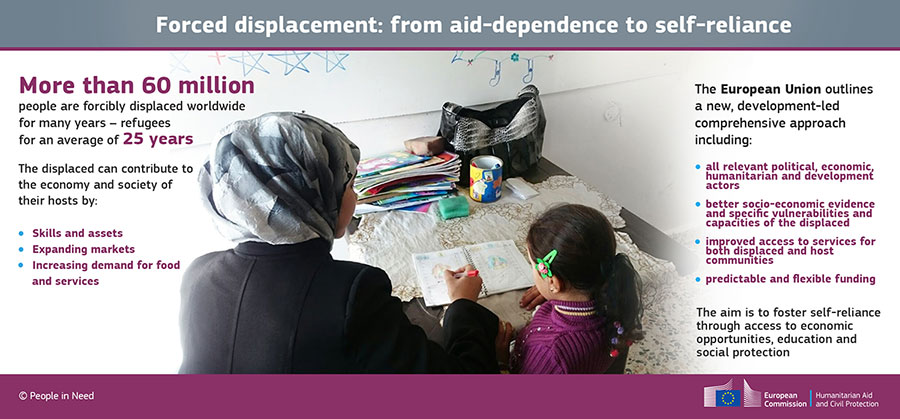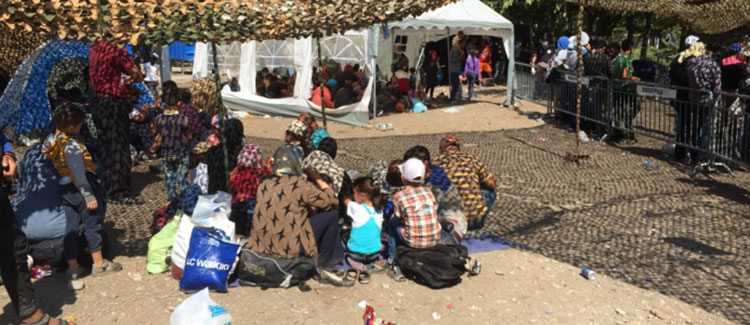Each year millions of people are forced to leave their homes and seek refuge from conflicts, violence, human rights violations, persecution or natural disasters. The majority of today’s refugees live in the developing world, which means that they flee to countries already struggling with poverty and hardship. Their survival usually depends on the availability of assistance which is provided by local communities and international organisations.
There are over 65 million people in dire need of protection and assistance as a consequence of forced displacement. They include refugees, internally displaced persons (IDPs) and asylum-seekers. Globally, over 38.2 million people are displaced within their own country, while more than 19.5 million are refugees and over 1.8 million are asylum-seekers. Alarmingly, 51% of the global refugee population are children under 18, the highest proportion in a decade. Women and girls represent 50% of the entire refugee population (source: UNHCR Global Trends 2014).
Syria became the world’s largest source country of refugees during 2014 with over 4 million people, overtaking Afghanistan which had held this position for more than 30 years. They are followed by Somalia, Sudan, South Sudan and the Democratic Republic of Congo (DRC).
Around four-fifths of the world’s refugees have fled from the crisis areas into neighbouring countries such as Pakistan, Iran, Lebanon, Jordan and Turkey. Turkey is the largest refugee-hosting country worldwide, with 2.9 million refugees (March 2016). Turkey is followed by Pakistan (1.5 million), Lebanon (1.1 million), the Islamic Republic of Iran (982 000), Ethiopia (659 500) and Jordan (654 100). (UNHCR Global Trends 2014).
From the total of 40.8 million internally displaced people in the world, currently most live in Syria (6.6 million) and Colombia (over 6.3 million). Iraq and Sudan follow with over 3 million each. Yemen, Nigeria, South Sudan, Ukraine, DRC and Pakistan complete the list of the first ten countries, which together account for 75% of the world’s all IDPs (IDMC 2016 Global Overview).
 Over €1 billion to help refugees in 2015
Over €1 billion to help refugees in 2015
As leading global donor, the European Commission gave more than €1 billion or some 72% of its annual humanitarian aid budget in 2015 to projects helping refugees and IDPs in over 30 countries. Humanitarian aid for refugees delivered by the European Commission helps to:
- meet the most pressing needs of refugees;
- protect and support refugees during their displacement and when returning to their place of origin; and
- increase the self-reliance of refugees and reduce their dependency on assistance.
The Commission’s Humanitarian Aid and Civil Protection department (ECHO) invests heavily in assisting refugees who are trapped in protracted situations (in exile for five years or more without prospects of immediate durable solutions), which affect more than 45% of the world’s refugees. It is currently responding to needs of refugee population such as: Syrian refugees in Jordan, Lebanon, Turkey, Greece and Iraq, Afghan refugees in Iran and Pakistan, Somali refugees in Kenya and Yemen, Congolese refugees in the Great Lake region, Colombian refugees in Ecuador and Venezuela, Myanmar refugees in Thailand, Rohingya refugees in Bangladesh and Sahrawi refugees.
The Commission channels its support through organisations helping with migrants, refugees and IDPs. The Commission’s main partners include UNHCR, the International Organisation for Migration (IOM), the Red Cross and Red Crescent family and non-governmental organisations.
In April 2016, the European Commission, in association with the European External Action Service (EEAS), adopted a new development-led approach to forced displacement, aimed at harnessing and strengthening the resilience and self-reliance of both the forcibly displaced and their host communities. Political, economic, development and humanitarian actors should be engaged from the outset and throughout displacement crises to work with third partner countries towards gradual socio-economic inclusion of the forcibly displaced.
While supporting the victims of displacement, the European Commission is also working to decrease the number and scale of refugee crises: for instance, through its work on disaster preparedness and prevention, which aims to reduce the vulnerability of disadvantaged communities and prevent their displacement.



